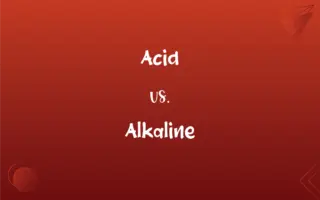Poison vs. Venom: What's the Difference?
Edited by Janet White || By Harlon Moss || Updated on October 23, 2023
Poison is a harmful substance absorbed, ingested, or inhaled, while venom is a toxic secretion injected by animals through stings or bites.

Key Differences
Both poison and venom are substances that can cause harm or death to organisms. The major distinction between the two lies in their modes of delivery and how they interact with their target.
Poison refers to any substance that, when introduced to an organism, can cause harm. It might be ingested, inhaled, or simply come into contact with the skin. Plants, animals, and various chemicals can all be sources of poison. In contrast, venom is a specialized substance produced by certain animals, specifically to incapacitate or harm their prey or as a defense mechanism.
Venomous creatures, such as snakes, spiders, and certain fish, have evolved specialized structures like fangs, stingers, or spines to inject venom into their victims. On the other hand, poisonous creatures don’t typically deliver their poison actively. Instead, harm occurs when a predator eats or touches them.
It's essential to recognize this difference in the event of a harmful encounter. For venom, quick medical attention might involve neutralizing the venom or treating a bite or sting. For poison, treatment could entail eliminating the poison from the system or neutralizing its effects.
In cultural contexts, poison often carries connotations of intentional harm, such as in cases of poisoning. Venom, meanwhile, is usually associated with specific animals and their natural behavior, often not directed intentionally at humans.
ADVERTISEMENT
Comparison Chart
Method of Delivery
Absorbed, ingested, inhaled
Injected by a bite, sting, or specialized structure
Source
Plants, animals, chemicals
Specific venomous animals
Intentionality
Typically passive (e.g., when touched or eaten)
Active (e.g., via a bite or sting)
Treatment
Neutralize or eliminate the poison
Neutralize venom, treat bite or sting
Cultural Connotations
Often associated with intentional harm
Linked with specific animals and natural behavior
ADVERTISEMENT
Poison and Venom Definitions
Poison
Poison is a substance capable of causing harm or death when introduced to an organism.
Some mushrooms contain poison that can be fatal if ingested.
Venom
It's associated with certain groups of animals, like snakes, spiders, and some marine creatures.
Cone snails use venom to immobilize their prey.
Poison
It's any substance that can cause harm through chemical reactions or activity on molecular receptors.
Lead is a poison that can harm the nervous system.
Venom
Venom is a toxic secretion of animals, usually delivered through a bite or sting.
The rattlesnake injected venom into its prey with a quick bite.
Poison
Poison can be used metaphorically to refer to something harmful or corrupting.
Rumors are the poison of friendships.
Venom
Venom, in a figurative sense, can also refer to maliciousness or spite.
Her words were filled with venom during the argument.
Poison
It is a material that, upon ingestion, inhalation, absorption, or contact, can adversely affect living organisms.
Cleaning agents can contain poison and should be kept away from children.
Venom
It's a specialized substance produced for defense or capturing prey.
The scorpion's tail delivers venom that can paralyze small animals.
Poison
Poison often refers to something that damages or impairs.
Hate is like a poison that corrupts the soul.
Venom
Venom typically contains a mix of enzymes, toxins, and other compounds.
Spider venom can have various effects depending on the species.
Poison
A substance that causes injury, illness, or death, especially by chemical means.
Venom
A poisonous secretion of an animal, such as a snake, spider, or scorpion, usually transmitted to prey or to attackers by a bite or sting.
FAQs
Can touching a frog make you poisoned?
Some frogs secrete poison that can be harmful when touched.
How does venom work on a molecular level?
Venom contains enzymes and toxins that can disrupt cell functions, clot blood, or damage tissues.
Are all snakes venomous?
No, only certain species of snakes produce venom.
Is venom always fatal to humans?
Not all venoms are fatal; the effect depends on the venom type and the amount delivered.
Is antivenom made from venom?
Yes, antivenom is produced using small amounts of venom to elicit an immune response.
Can venom be artificially synthesized?
Some venom components can be synthesized, but many are complex and difficult to replicate.
What's the most poisonous substance known?
Botulinum toxin, produced by a bacterium, is among the most poisonous substances.
Are there antidotes for all poisons?
Not all poisons have specific antidotes, but general treatments can help manage many cases.
Can a poison become venomous?
No, poison and venom are distinct based on their mode of delivery.
Can venoms be used for research purposes?
Yes, venom components can be crucial for biomedical research and drug development.
How can one treat a venomous bite?
Seek immediate medical attention; antivenom might be required.
What's the difference between poison ivy and a venomous plant?
Poison ivy causes harm when touched; a venomous plant would need to inject its toxin.
Can you drink snake venom without harm?
Ingesting venom is generally less harmful than being injected, but it's risky and not advised.
Is poison always a liquid?
No, poison can be solid, liquid, or gas.
How do venomous animals avoid their venom?
They have specialized mechanisms or immunity to their venom.
Are there animals that are both poisonous and venomous?
Yes, some animals like certain frogs can be both.
How can I know if a substance is poisonous?
Always refer to labels, and when in doubt, consult a specialist or avoid contact.
Why do some animals develop venom?
Venom has evolved for defense and to help in capturing and digesting prey.
Are there beneficial uses for poison?
Some poisons have medicinal properties or are used in research.
Can venom be used in medicine?
Yes, certain venoms have properties that can be used for medical treatments.
About Author
Written by
Harlon MossHarlon is a seasoned quality moderator and accomplished content writer for Difference Wiki. An alumnus of the prestigious University of California, he earned his degree in Computer Science. Leveraging his academic background, Harlon brings a meticulous and informed perspective to his work, ensuring content accuracy and excellence.
Edited by
Janet WhiteJanet White has been an esteemed writer and blogger for Difference Wiki. Holding a Master's degree in Science and Medical Journalism from the prestigious Boston University, she has consistently demonstrated her expertise and passion for her field. When she's not immersed in her work, Janet relishes her time exercising, delving into a good book, and cherishing moments with friends and family.
































































